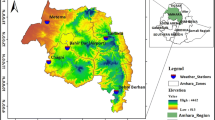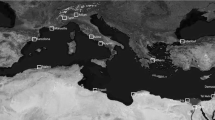Abstract
Based on non-radiance-calibrated DMSP/OLS nighttime light imagery from 1992 to 2003, urban land area statistical data, meteorological data and land surface temperature data retrieved by MODIS and NOAA/AVHRR data, the influence of urbanization on regional climatic trend of temperature in the Yangtze River Delta (YRD) was analyzed. Conclusions are as follows: 1) There is a significant urbanization process from 1992 to 2003 in the YRD. Four city clusters of Nanjing-Zhenjiang-Yangzhou, Suzhou-Wuxi-Changzhou, Shanghai and Hangzhou Bay form a zigzag city belt. The increase rate of annual mean air temperature in city-belt is 0.28–0.44°C/10a from 1991 to 2005, which is far larger than that of non-city-belt. 2) The urban heat island (UHI) effect on regional mean air temperature in different seasons is summer>autumn>spring>winter. 3) The UHI intensity and the urban total population logarithm are creditably correlated. 4) The UHI effect made the regional annual mean air temperature increased 0.072°C from 1961 to 2005, of which 0.047°C from 1991 to 2005, and the annual maximum air temperature increased 0.162°C, of which 0.083°C from 1991 to 2005. All these indicating that the urban expansion in the YRD from 1991 to 2005 may be regarded as a serious climate signal.
Similar content being viewed by others
References
Chen Longxun, Zhu Wenqin, Zhou Xiuji, 2000. Characteristics of environmental and climate change in Changjiang Delta and its possible mechanism. Acta Meteorologica Sinica, 14(1): 129–140.
Chen Longxun, Zhu Wenqin, Zhou Xiuji et al., 2003. Characteristics of the heat island effect in Shanghai and its possible mechanism. Adv. Atmos. Sci., 20(6): 991–1001.
Chu Ziying, Ren Guoyu, 2005. Change in urban heat island magnitude and its effect on mean air temperature record in Beijing region. Acta Meteorologica Sinica, 63(4): 534–540. (in Chinese)
Ding Jincai, Zhang Zhikai, Xi Hong et al., 2002. A study of the high temperature distribution and the heat island effect in the summer of the Shanghai area. Chinese Journal of Atmospheric Sciences, 26(3): 412–420. (in Chinese)
David E Parker, 2004a. A demonstration that large-scale warming is not urban. Journal of Climate, 19: 2882–2895.
David E Parker, 2004b. Large-scale warming is not urban. Nature, 432: 290–290.
He Chunyang, Li Jinggang, Chen Jin et al., 2005. The urbanization model and process in Bohai Sea surrounding area in the 1990s by using DMSP/OLS data. Acta Geographica Sinica, 60(3): 409–417. (in Chinese)
He Chunyang, Shi Peijun, Li Jinggang et al., 2006. Restoring urbanization process in China in the 1990s by using non-radiance-calibrated DMSP/OLS nighttime light imagery and statistical data. Chinese Science Bulletin, 51(13): 1614–1620.
Imhoff M L, Bounoua L, Defries R et al., 2004. The consequences of urban land transformation on net primary productivity in the United States. Remote Sensing of Environment, 89: 434–443.
Imhoff M L, Lawrence W T, Elvidge C et al., 1997. A technique for using nighttime DMSP/ OLS images of city lights to estimate the impact of urban land use on soil resources in the US. Remote Sensing of Environment, 59: 105–117.
Imhoff M L, Lawrence W T, Stutzer D C et al., 1997. A technique for using composite DMSP/ OLS city lights Satellite data to accurately map urban areas. Remote Sensing of Environment, 61: 261–370.
Intergovernmental Panel on Climate Change (IPCC) (2001), Climate Change 2001: The Scientific Basis. Contribution of Working Group 1 to the Third Assessment Report of the Intergovernmental Panel on Climate Change, Houghton J T et al. (ed.). New York: Cambridge University Press, 881.
Ji Chongping, Liu Weidong, Xuan Chunyi, 2006. Impact of urban growth on the heat island in Beijing. Chinese Journal of Geophysics, 49(1): 69–77. (in Chinese)
Kalnay Eugenia, Cai Ming, 2003. Impact of urbanization and land-use change on climate. Nature, 423: 528–531.
Kalnay Eugenia, Cai Ming, Li Hong, 2006. Estimation of the impact of land-surface forcings on temperature trends in eastern United States. Journal of Geophysical Research, 111(D06106): 1–13.
Li Q, Zhang H, Liu X et al., 2004. Urban heat island effect on annual mean temperature during the last 50 years in China. Theoretical and Applied Climatology, 79(34): 165–174.
Li Weiliang, Liu Hongli, Zhou Xiuji, 2003. Analysis of regional atmospheric circulation influence on the urban heat island at Taihu Lake in Yangtze River Delta. Science in China (Series D), 33(2): 97–104. (in Chinese)
Lim Young-kown, Cai Ming, Kalnay E, 2005. Observational evidence of sensitivity of surface climate changes to land types and urbanization. Geophys. Res. Lett., 32, L22712, doi: 10.1029/2005GL024267.
Lin Xuechun, Yu Shuqiu, 2005. Interdecadal changes of temperature in the Beijing region and its heat island effect, Chinese Journal of Geophysics, 48(1): 39–45. (in Chinese)
Oke T R, 1973. City size and the urban heat island. Atmospheric Environment, 7: 769–779.
Pielke R A Sr et al., 2002. The influence of land-use change and landscape dynamics on the climate system: Relevance to climate-change policy beyond the radiative effects of greenhouse gases. Phil. Trans. R. Soc. Lond., A360: 1–15.
Shi Neng, Chen Jiaqi, 1994. 4-phase climate change features in the last 100 years over China. Acta Meteorologica Sinica, 18(5): 552–560. (in Chinese)
Sutton P, 1997. Modeling population density with nighttime satellite imagery and GIS. Computers Environment and Urban Systems, 21(3–4): 227–244.
Thomas C Peterson, 2003. Assessment of urban versus rural in situ surface temperatures in the contiguous United States: No difference found. Journal of Climate, 16(18): 2941–2959.
Xie Zhuang, Cao Hongxing, 1996. A symmetric changes in maximum and minimum temperature in Beijing. Theoretical and Applied Climatology, 55: 151–156.
Zhang Jingyong, Dong Wenjie, Wu Lingyun, 2005. Impact of land use changes on surface warming in China. Advances in Atmospheric Sciences, 22(3): 343–348. (in Chinese)
Zhou Liming, Robert E Dickinson, Tian Yuhong et al., 2004. Evidence for a significant urbanization effect on climate in China. PNAS, 101(26): 9540–9544.
Zhou Xiuji, 2004. Research of Near Stratum Atmosphere and Ecosystem Interface of Delta of the Yangtze River. Beijing: China Meteorological Press. (in Chinese)
Zhuo Li, Li Qiang, Shi Peijun et al., 2006. Identification and characteristics analysis of urban land expansion types in China in the 1990s using DMSP/OLS data. Acta Geographica Sinica, 61(2): 169–178. (in Chinese)
Author information
Authors and Affiliations
Corresponding author
Additional information
Foundation: Concentrated fund item of national science and technology foundation work, No.2005DKA31700-06-20; Jiangsu Natural Science Foundation, No.BK2005163; Climate change special foundation of China Meteorological Administration, No.CCSF2006-32
Author: Du Yin (1978–), Ph.D Candidate, specialized in climatic changes.
Rights and permissions
About this article
Cite this article
Du, Y., Xie, Z., Zeng, Y. et al. Impact of urban expansion on regional temperature change in the Yangtze River Delta. J. Geogr. Sci. 17, 387–398 (2007). https://doi.org/10.1007/s11442-007-0387-0
Received:
Accepted:
Issue Date:
DOI: https://doi.org/10.1007/s11442-007-0387-0




